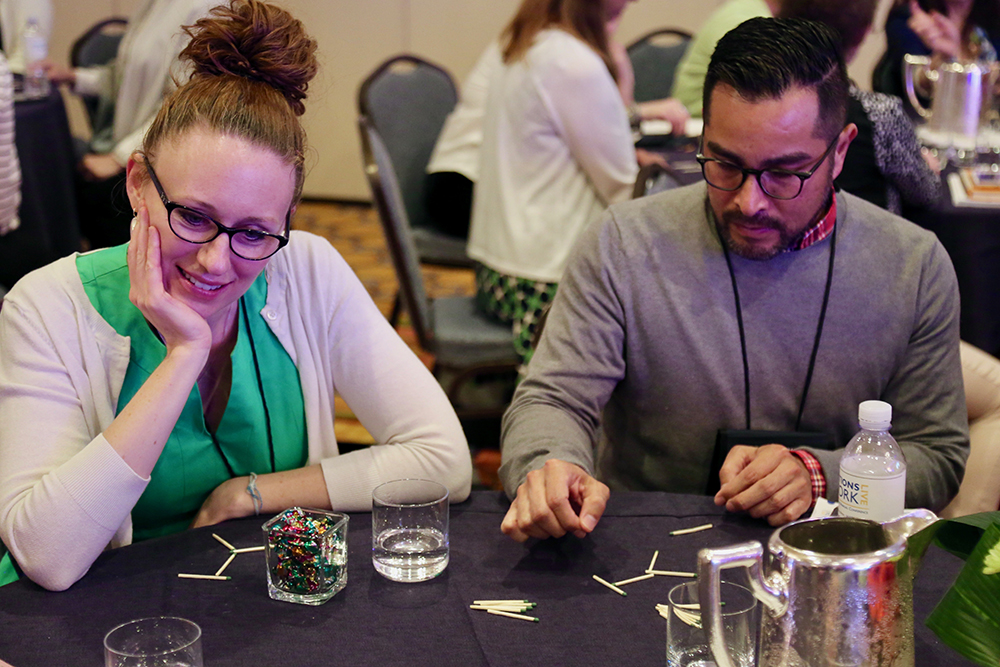Recently we asked participants at our Solutions at Work LIVE conference to complete two small challenges.
The first had to be done solo, on the clock, with the focus on being correct.
The second had to be done with a group, following introductions and sharing a (semi) embarrassing fact, with the focus on being creative.
Then we asked participants to describe the experience with a single word.
After the second, they used words like fun and collaborative. In task two, participants were also more likely to try something unconventional.
So what's the difference? The improved ability to effectively participate in the task came down the conditions of trust and belonging. By connecting people to each other and opening the door to a little bit of vulnerability (hence the semi-embarrassing fact), we freed people to feel safe enough to be creative, to take chances, and to do their best work.
The science of the human brain shows that trust and belonging - feelings of safety -- are essential to innovation. When people are stressed, their vision narrows; they contract; they can't think broadly. Think of the number of times you (or one of your employees) have gotten stuck in what's known as loop thinking; when you're endlessly focused on some minor and insignificant detail to avoid the bigger challenge. It's a stress response that steers you away from what's important. And it's a direct result when people don't feel safe.
That changes when people do feel connected and supported. Then, a part of the brain lights up that enables them to see more broadly; think more clearly; come up with more creative solutions.
Not incidentally, benefits and supportive people practices are also hallmarks of what people identify as their Dream Companies. In fact, when we asked employees to describe the experience of working in their Dream Company, one of the most oft-used words was "innovative."
When we build supportive environments, they bring out more than just happy employees. They bring out the magic of innovation.
The first had to be done solo, on the clock, with the focus on being correct.
The second had to be done with a group, following introductions and sharing a (semi) embarrassing fact, with the focus on being creative.
Then we asked participants to describe the experience with a single word.
Moving People from Frustrated to Fun
After the first task, participants reported they were frustrated, challenged, stressed, and defeated.After the second, they used words like fun and collaborative. In task two, participants were also more likely to try something unconventional.
So what's the difference? The improved ability to effectively participate in the task came down the conditions of trust and belonging. By connecting people to each other and opening the door to a little bit of vulnerability (hence the semi-embarrassing fact), we freed people to feel safe enough to be creative, to take chances, and to do their best work.
The science of the human brain shows that trust and belonging - feelings of safety -- are essential to innovation. When people are stressed, their vision narrows; they contract; they can't think broadly. Think of the number of times you (or one of your employees) have gotten stuck in what's known as loop thinking; when you're endlessly focused on some minor and insignificant detail to avoid the bigger challenge. It's a stress response that steers you away from what's important. And it's a direct result when people don't feel safe.
That changes when people do feel connected and supported. Then, a part of the brain lights up that enables them to see more broadly; think more clearly; come up with more creative solutions.
How Trust Builds Innovation
Study after study shows this to be true; that work groups - a sports team, a flight crew, any team - solve problems better and more quickly when they've built those connections. And you want that kind of problem solving - that kind of innovation - going on at every level of your workforce. Innovation isn't just for R&D; it's not just a technology thing. In great organizations, innovation happens throughout the organization all the time, because people feel safe enough to present all ideas - even silly ones - whether that means simplifying a process that happens tens of thousands of times a day, or creating opportunity from an event that will only happen once.Harnessing the Formula for Innovation
Our little experiment was obviously on a tiny scale. But the kinds of cultures we create in our workplaces have the potential to create the same kinds of results. More than 1,500 full-time working people in our Innovation study told us that supportive people practices - including good benefits and promoting work-life balance - are tied to collaboration and innovation. In other words, support creates collaboration, and collaboration creates trust, and trust creates the conditions for innovation. And right there is your formula. The upshot is that supportive people practices are critical to organizations that are innovative.Not incidentally, benefits and supportive people practices are also hallmarks of what people identify as their Dream Companies. In fact, when we asked employees to describe the experience of working in their Dream Company, one of the most oft-used words was "innovative."
When we build supportive environments, they bring out more than just happy employees. They bring out the magic of innovation.





